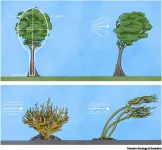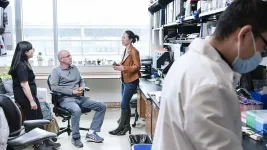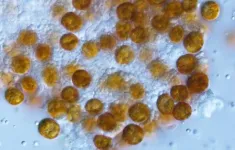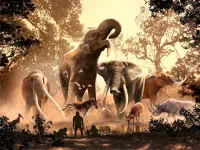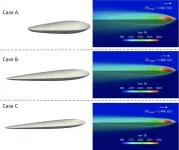(Press-News.org) A team of scientists has devised a more accurate way to predict the effects of climate change on plants and animals -- and whether some will survive at all.
Frequently, ecologists assess an organism's fitness relative to the climate by quantifying its functional traits.
"These are physical properties you can measure -- height, diameter, the thickness of a tree," said UC Riverside biologist Tim Higham. "We believe more information is needed to understand how living things will respond to a changing world."
The team, led by Higham, outlines an alternative model for researchers in an article published today in the journal Trends in Ecology and Evolution.
This new model incorporates the functional traits of an organism as well as environmental variables, such as temperature, habitat structure, and the speed of wind or water an organism interacts with. The team calls these "ecomechanical models."
As oceans rise, strong storms will reach farther inland. The intensity of hurricanes, and the proportion of hurricanes that reach very intense levels, will likely increase with climate change. As a result, Higham said that fluids will exert greater forces on anything in their path. These forces could cause organisms with roots, such as trees, to break or be uprooted.
"If you measure the functional traits of a tree, and we know the speed of the wind, we can predict how much bending will occur," Higham said. "At certain wind speeds, the tree will potentially come down."
The way wind disperses seeds, or how insects and birds fly in the face of strong winds, can potentially influence their fitness. When considering the fate of living things, the physics governing the way they move through space is another important factor accounted for by this new framework. In this sense, ecomechanical models are not limited to understanding the impacts of climate change.
"They can help scientists understand evolutionary patterns and how animals interact differently with their environment as they grow," Higham said.
Environmental conditions can affect how some animals attach to surfaces. For example, geckos can use their famous adhesive system to attach to smooth surfaces. However, the real-world is not often smooth. Therefore, understanding how geckos attach requires knowledge of both the animal's functional traits and the environment's texture, for example.
In order to facilitate use of this model by many different types of scientists, the research team urges the expansion of freely available online databases in which functional traits of organisms have been described in a uniform, standardized way.
This work was years in the making, the product of a working group funded by the National Science Foundation. The group is composed of 24 scientists from Arizona State University; Claremont Colleges; University of British Columbia; University of Illinois, Clark University; the University of Calgary, The State University of Northern Rio de Janeiro, Brazil; Rutgers University; University of Waterloo in Ontario, Canada; University of Washington; George Washington University; Trinity University; UC Berkeley; Cornell University; Towson University, and the American Museum of Natural History.
Many of the participating faculty identify as members of underrepresented groups in science. "Including faculty in early career stages, and from a diversity of backgrounds and lived experiences was of paramount importance to us as we created the working group," said Lara Ferry, biologist and President's Professor from Arizona State University. "We know the best results come from the collective contributions of many different perspectives."
Should these recommendations become widely adopted, the research team feels there will be profound impacts on multiple areas of biology.
"The use of ecomechanical models can help us understand the rules of life," Higham said.
INFORMATION:
NEW YORK, NY (July 1, 2021)--Lowering levels of a hormone called PTHrP can prevent metastases and improve survival in mice with pancreatic cancer and could lead to a new way to treat patients, according to a study from cancer researchers at Columbia University Vagelos College of Physicians and Surgeons and Herbert Irving Comprehensive Cancer Center and with collaborators at the University of Pennsylvania.
When patients are first diagnosed with pancreatic cancer, the cancer usually has spread to other organs. Because of these metastases, nearly all patients will succumb to their cancer within one year of diagnosis, but no drugs exist to prevent metastasis.
In an effort to find treatments, cancer researchers at Columbia--led by ...
What if a microscope allowed us to explore the 3D microcosm of blood vessels, nerves, and cancer cells instantaneously in virtual reality? What if it could provide views from multiple directions in real time without physically moving the specimen and worked up to 100 times faster than current technology?
UT Southwestern scientists collaborated with colleagues in England and Australia to build and test a novel optical device that converts commonly used microscopes into multiangle projection imaging systems. The invention, described in an article in today's Nature Methods, could open new avenues ...
SAN FRANCISCO, CA--June 28, 2021--While vaccines are doing a remarkable job of slowing the COVID-19 pandemic, infected people can still die from severe illness and new medications to treat them have been slow to arise. What kills these patients in the end doesn't seem to be the virus itself, but an over-reaction of their immune system that leads to massive inflammation and tissue damage.
By studying a type of immune cells called T cells, a team of Gladstone scientists has uncovered fundamental differences between patients who overcome severe COVID-19 and those who succumb to it. The team, working together with researchers from UC San Francisco and Emory University, also found that dying patients harbor relatively large numbers of T cells able to infiltrate the lung, which may contribute ...
BUFFALO, N.Y. -- Patients with Type 2 diabetes who were prescribed SGLT2 inhibitors lost more weight than patients who received GLP-1 receptor agonists, according to a University at Buffalo-led study.
The research, which sought to evaluate the difference in weight loss caused by the antidiabetic medications -- both of which work to control blood sugar levels -- found that among 72 patients, people using SGLT2 inhibitors experienced a median weight loss of more than 6 pounds, while those on GLP-1 receptor agonists lost a median of 2.5 pounds.
The findings, published last month ...
The adult brain is more malleable than previously thought, according to researchers from the Interdisciplinary Center Herzliya. They trained a 50-year-old man, blind from birth, to "see" by ear, and found that neural circuits in his brain formed so-called topographic maps - a type of brain organization previously thought to emerge only in infancy. This finding reported recently in END ...
Rochester, Minn. -- Mayo Clinic researchers have discovered that genetic variants in a neuro-associated gene called SPTBN1 are responsible for causing a neurodevelopmental disorder. The study, published in Nature Genetics, is a first step in finding a potential therapeutic strategy for this disorder, and it increases the number of genes known to be associated with conditions that affect how the brain functions.
"The gene can now be included in genetic testing for people suspected of having a neurodevelopmental disorder, which may end the diagnostic odyssey these people and their families have endured," says Margot Cousin, Ph.D., a translational ...
UNIVERSITY PARK, Pa. -- In the late 1800s, scientists were stumped by the "yellow cells" they were observing within the tissues of certain temperate marine animals, including sea anemones, corals and jellyfish. Were these cells part of the animal or separate organisms? If separate, were they parasites or did they confer a benefit to the host?
In a paper published in the journal Nature in 1882, biologist Sir Patrick Geddes of Edinburgh University proffered that not only were these cells distinct entities, but they were also beneficial to the animals in which they lived. He assigned them to a new genus, Philozoon -- from the Greek phileo, meaning 'to love ...
Giving women in India's Madhya Pradesh state greater digital control over their wages encouraged them to enter the labor force and liberalized their beliefs about working women, concluded a new study co-authored by Yale economists Rohini Pande and Charity Troyer Moore.
The study, published in the American Economic Review, found that a relatively simple intervention directed to poor women -- providing them access to their own bank accounts and direct deposit for their earnings from a federal workfare program, along with basic training on how to use local bank kiosks -- increased the amount ...
Based on fossil finds, we know that the vast majority of species that once inhabited the earth have become extinct. For example, there are about 5,500 mammal species living on the planet today, but we know of at least 160,000 fossil species, so for every mammal species living today, there are at least 30 extinct ones. We therefore know with great certainty that the lineages of living things come and go along immense time scales. But what factors cause these lineages to come into being and disappear is still an unsolved question.
To investigate ...
Additive manufacturing has the potential to allow one to create parts or products on demand in manufacturing, automotive engineering, and even in outer space. However, it's a challenge to know in advance how a 3D printed object will perform, now and in the future.
Physical experiments -- especially for metal additive manufacturing (AM) -- are slow and costly. Even modeling these systems computationally is expensive and time-consuming.
"The problem is multi-phase and involves gas, liquids, solids, and phase transitions between them," said University of Illinois Ph.D. student Qiming ...
